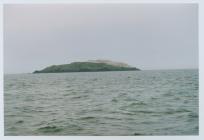Content can be downloaded for non-commercial purposes, such as for personal use or in educational resources.
For commercial purposes please contact the copyright holder directly.
Read more about the The Creative Archive Licence.
Description
Lede
This internationally important bird isle offers spectacular wildlife - all in black and white.
Story
We may associate seabirds with islands – puffins standing sentinel on ledges, guillemots in serried ranks on slim ledges – but this is only a temporary habitat. On land they are edgy, vulnerable to predation. These are, after all, sea birds and the gannet spends most of its life far out there, wheeling against the wind on barely moving, riding the air no matter how turbulent it is. They only rest on the waves when they really have to, and stay far away from shore other than when that ancient urge takes them to isolated headlands and islands to breed. Just take a look at auks such as razorbills and guillemots on their breeding ledges in early spring, just after they’ve come in off the sea, how jittery they are, because exposed. But we humans tend to see them as birds of islands simply because we are hardly ever able to see them out over open ocean, where birds such as storm petrels, no bigger than a house sparrow are very much at home, even in a gale.
The Latin name of the gannet, Morus bassana, refers to one of its most famous colonies, Bass Rock in the Firth of Forth. As far back as the early sixteenth century visitors were noting their presence on this great slab of geology: ‘Near to Gleghornie, in the ocean, at a distance of two leagues, is the Bass Rock, wherein is an impregnable stronghold. Round about it is seen a marvellous multitude of great duck that live on fish.’
The ‘great ducks’ are easy to spot when patrolling the waves for a flicker of herring-silver, but when they fish they are simply unmistakable. From a height of up to 140 feet they collapse their wings and their bodies become living spearheads. They plummet toward their prey at a speed of up to 100 kms an hour, or as the poet Christine Evans has it, ‘Gannets fall/as if fired back/by sky they have stretched/with their slow, strong wing beats.’ Before they hit the surface of the sea small air sacs in the head fill up, exactly like the airbags that cushion a human car passenger from impact. The fine nature writer Tim Dee has captured the kinetic vibrato, the sheer thrill of this avian spectacle – which easily rivals that of African Big Game – and the plunging exhilaration of the dive:
Again and again they do the same thing to catch their food, but each dive shines. Nature’s repetitions are never boring. Every time it is like witnessing a fresh marvel in a new world; their visible decision-making, with its corrective twisting and corkscrewing, the rapid origami of themselves, and then their brilliant white match strikes, fizzing into the water (at 60 mph) to leave puffs of lit sea spray. It is hard not to blink and hold your breath as they go in.
The rapid origami of themselves – a phrase worth repeating!
Factoid
-Young gannets fly south when they leave Grassholm and many have been recovered, or found dead on the coast of Morocco, Senegal and Mauritania.





Do you have information to add to this item? Please leave a comment
Comments (0)
You must be logged in to leave a comment